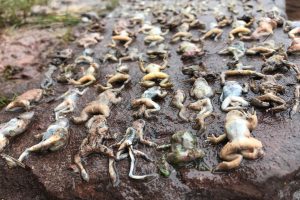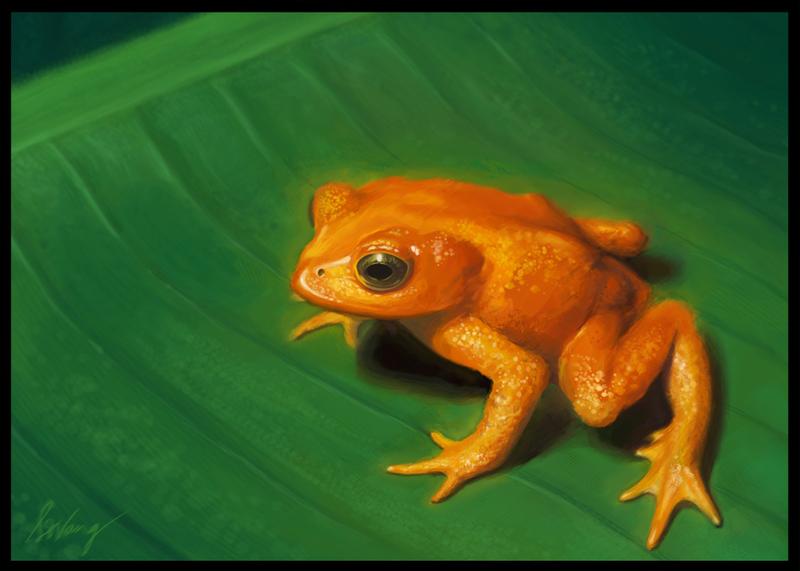Jordan Haber
What’s the Buzz?
21 March 2020
Amphibians are more than the croaking insect eating creatures that inhabit ponds and creeks, in fact, every year millions of amphibians are traded globally for food, pets, and research. Ironically, in a 2020 review of global amphibian declines, scientists blame this global amphibian trade for exporting a deadly genus of fungus across 6 continents. The herpetologists, who specialize in amphibians and reptiles, claim the fungus is the primary cause of global amphibian declines.
According to the review, the global circulation of amphibians who are not impacted by the fungus are believed to be the main vectors of the disease. The North American Bullfrog (Lithobates catesbeianus) and the African Clawed Frog (Xenopus laevis) are particularly heavily traded and both these species are known carriers of Batrachochytrium dendrobatidis (Bd) which is the primary fungal species behind global declines in frogs.
Despite being Bd carriers, both the North American Bullfrog and African Clawed Frog are unaffected by the fungus. Unfortunately, both of these species have been either accidentally or intentionally released into environments inhabited by more readily Bd impacted species. Once Bd has entered the environment, it can survive anywhere hosts can be found.

The African Clawed Frog is commonly found in pet shops across the world, but thanks to the doing of irresponsible pet owners, the African Clawed Frog is now considered an invasive species in North America. The African Clawed Frog pictured above was caught in the Santa Ana Watershed in California.
Bd is a species of Chytrid fungus, meaning it produces zoospores or spores that contain flagellates, the cellular equivalent of a tail. According to Mathew Fisher, a herpetologist and professor at Imperial College London, “The zoo spores that are produced by Bd, swim through the water and when they strike the amphibian skin they deploy some potent enzymes called proteases…”. According to professor Fisher, these proteases burn their way through amphibian skin allowing the zoospores to reproduce and spread.
According to the findings of the 2020 review, one of the reasons this fungus is so deadly amongst amphibians is that amphibians undergo the process of osmoregulation in which they respire through their water permeable skin. When the skin becomes too lacerated, osmoregulation declines, and amphibians often die from what in humans would be the equivalent of a heart attack.

Above, two free swimming Bd specimens are depicted using their tail-like flagella to propel themselves through water.
Scientists first began to recognize the global decline in frog populations in the 1970s, but it wasn’t until 1990 that two independent studies in Australia and Central America identified Bd as a potential culprit. We now know Bd likely originated somewhere in Asia, where thanks to the global pet trade it was unintentionally exported to 5 other continents and several island nations. Thanks to the hard work of many scientists, Bd is now much better understood and anti-fungal treatments are currently being developed.

Arranged in rows by researchers, these Midwife Toads fell victim to the deadly Bd fungus despite living high up in the French Pyrenees.
According to Fisher, however, one of the challenges of Bd is that it’s an enigmatic disease meaning it can occur in remote areas untouched by habitat destruction. “This makes studying the fungus outside a lab environment extremely difficult” Fisher says. The Midwife Toad (Alytes obstetricans) for instance is one of the most impacted amphibian species impacted by Bd despite living high up in remote alpine ponds in the Pyrenees mountains that border Spain and France.
In response to the Bd pandemic, countries such as the US, have imposed significant restrictions on the exports and imports of amphibians. Additionally, captive breeding stations have been set up across North America, Australia, and Europe to help flood the market with Bd free amphibian species. Successful tests of Bd anti-fungal treatments also bring home that perhaps one day Bd can be eliminated from the environment. In the meantime, however, amphibians remain one of the most endangered classes of animal and their future remains uncertain.
References:
Fisher, C. F., and Garner, W., J. 2020. Chytrid Fungi and Global Amphibian Decline. Nature 109.

maricha
It’s interesting to think that humans aren’t only species dealing with the global spread of diseases. This article did a good job of profiling the fungus and calling attention to harmful industries like the pet trade. The use of quotes by the herpetologist was well-structured and well-placed. Nice article!